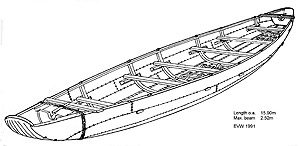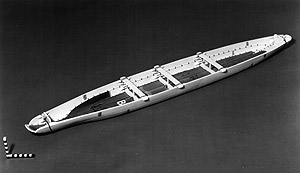Bronze Age Yorkshire – the five boats from Ferriby
On five occasions between 1937 and 1989 prehistoric boat remains were found on the Humber foreshore at North Ferriby. Some of these finds were sufficiently extensive to give an impression of the size and general shape of the original vessel, whereas others were merely a single timber.

Ferriby Boat 1 (E.V. Wright) (Early Bronze Age 1880-1680 BC)
Ferriby 1 had the most remains: that boat and Ferriby 2 (two elements of a plank-keel) were excavated by E.V. and C.W. Wright in 1946. A third find, (a lowest side strake joined to part of an outer bottom plank, with no cleats visible) was excavated in 1963. Fragment Ferriby 4 proved to have no features that indicated it was from a boat; moreover it was alder (Alnus sp.), a species that has not been noted in any boat structure from Atlantic Europe. Ferriby 5, found in 1989, is part of a cleat similar to those on the Brigg ‘raft’. For several decades, these boat remains were held at the National Maritime Museum, Greenwich; all surviving Ferriby timbers are now in the care of Hull Museums. In 1996 a further fragment (with some features similar to those of the Ferriby boats) was found at Kilnsea on the North Sea coast, north of the mouth of the Humber.
Radiocarbon dates for the Kilnsea timber and Ferriby boats 1, 2, 3 & 5 range from 1905 BC to 1770 BC. As it is likely that some of the dated samples had been taken from mid-heartwood rather than the outer tree rings, it seems best to treat the parent boats of these timbers as of a similar age. Worldwide, the sewn-plank boats in this British group are second in age to a number of Egyptian boats (with sewn and wooden plank fastenings) that are dated to the early to mid-third millennium BC – among them the royal ship of Kufu (Cheops) of c. 2600 BC.
Since Ferriby 1, like all excavated boats, was incomplete and distorted, it was necessary to reconstruct, in a theoretical way, her original full form so that estimates could be made of her potential performance. Over the years Ted Wright (assisted by naval architect, Dr. John Coates) produced a number of hypothetical reconstructions ranging from a ‘minimum solution’ (a paddled ferry across and along the Humber and its tributaries) to a ‘much embellished’ reconstruction (a sail-propelled vessel capable of tackling the North Sea). Since the earliest evidence for sail in north-west Europe is not until the 1st century BC and for other reasons, the ‘minimum solution’ is preferred.

Ferriby Boat 1: reconstruction (Early Bronze Age 1880-1680 BC)
In 1958, Carbon-14 gave a date of 750±150 BC for the Ferriby Boats, confirming their Bronze Age origin. In the 1980s this was refined to c. 1300 BC for Ferriby Boats 1-3 but Ferriby Boats 4 and 5 were assigned a much later date of 400 BC. Yet later dating gave 1900 BC for Ferriby Boat 3, and 1800 BC for Ferriby Boats 1 and 2 as a result of which the Ferriby Boats were rightly acclaimed in March 2001 as Europe’s earliest known examples of seacraft. Similar craft have now also been recognised from Kilnsea, East Yorkshire (1870-1670 BC) and from Dover, Kent (1300-1200 BC).
North Ferriby lies at the foot of the Yorkshire Wolds. The Wolds are noted for an increasing intensity of prehistoric activity from the Neolithic onwards. The Ferriby site was an ideal point of departure for east/west travel along the Humber or as a crossing-point to the south bank. The Ferriby boats were a means by which ideas, such as the decorative design of pottery, and goods such as Baltic amber and metals could arrive on the Humber shore.